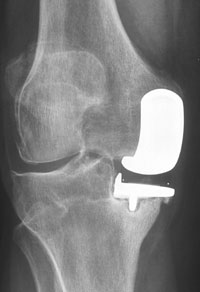Identifying pathology of failed UKA during exam and surgery aids conversion to TKA
For an optimal outcome, arthroplasty register data support revising UKAs to TKAs, not another UKA.
Unicompartmental knee arthroplasty results in the Swedish and Finnish knee arthroplasty registers include revision rates of 7% to 13%, but indicate most are revised to a total knee arthroplasty, according to an orthopedist at the Cleveland Clinic.
“The preferred treatment is to revise to a total knee. Do not revise a uni to another uni except in rare circumstances. Clearly it is ill advised to treat disease progression with a uni in the other compartment,” Mark I. Froimson, MD, MBA, said, citing registry results.
At the 10th Annual Current Concepts in Joint Replacement Spring Meeting, Froimson discussed unicompartmental knee arthroplasty (UKA) to total knee arthroplasty (TKA) conversions and the importance of clearly identifying the mode of UKA failure before performing revision surgery.
Clinical exam
|
Image: Froimson MI |
By carefully assessing the amount of bone loss in the knee and other key factors, the surgeon can usually perform a UKA to TKA revision that is as reliable as a primary TKA, according to Froimson.
“Primary components, both cruciate retaining or substituting, can be commonly employed. However, we need to be aware of when screws and cement or augments and stems are required and when more constraint is indicated,” he added.
Froimson suggested identifying instability and malalignment issues and ruling out infection and other causes of pain with a failed UKA during the clinical exam. He also recommended using standard radiographic assessments to identify significant bone loss.
Factors leading to UKA failures have been shown to differ based on if it is an early or late failure, with those failing early typically arising from poor patient selection or surgical technique that accelerated or caused instability or loosening, Froimson said.
He urged surgeons to look closely for early signs of tibial collapse and significant damage to the tibia.
“Late failures are a little easier to fix. Those are due to progression of disease or polyethylene failure and pose less of a structural problem.”
According to Froimson, the mode of failure, amount of bone loss and ligament insufficiency clearly influences the choice made during reconstruction.
Bone status
The failed UKA can be successfully revised to a total knee and be done most of the time with standard implants, Froimson said.
However, stems should be used if there has been any major metaphyseal bone loss. Tibial wedges and augments may be needed for major bone loss associated with tibial-side collapse and tibial defects seen with failed primary UKA. After preparing the tibia is the optimal time to determine the need for a stemmed tibial component, augment or perhaps tibial bone grafting done with excised native bone, Froimson said.
Bone loss on the femoral side is much less common and rarely requires special techniques. Therefore, during surgery, the most important step is characterizing the type of pathology and bone loss present, he noted.
Standard techniques for incisions, exposures, femoral and tibial preparation, ligament balancing and implant sizing can also be used if bone loss is minimized as much as possible.
For more information:
- Mark I. Froimson, MD, MBA, can be reached at Cleveland Clinic, 9500 Euclid Ave., Mail Code A41, Cleveland, OH 44195; 216-444-8784; e-mail: froimsm@ccf.org. He has intellectual property rights with DePuy, a Johnson & Johnson company.
Reference:
- Froimson MI. UKA to TKA conversion: Assuring a primary outcome. #46. Presented at the 10th Annual Current Concepts in Joint Replacement Spring Meeting. May 17-20, 2009. Las Vegas.

